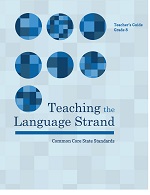Common Core Test Results
As teachers have focused on the reading and writing strands of the Common Core State Standards the past three years, the Language Strand Standards have been given short shrift. As the testing data from the 2015 SBAC (Smarter Balanced Assessment Consortium), the PAARC (Partnership of Assessment of Readiness for College and Careers), and other state tests has been or soon will be released, teachers and district personnel are identifying the instructional gaps and rediscovering why a balanced literacy program, including explicit instruction in grammar, usage, spelling, and vocabulary is so essential.
As of August 30, 2015, full or preliminary scores have been released for these states: Connecticut, Idaho, Missouri, Oregon, Vermont, Washington and West Virginia. Each participated in the Smarter Balanced Assessment Consortium (SBAC). The second testing group, the Partnership for Assessment of Readiness for College and Careers (PAARC) has not released any results. Several other states that developed their own exams tied to the standards have been released. Many states have adopted a cafeteria model, using some of the two consortia online assessments plus their own paper ad pencil achievement tests.
A Brief Case Study
In Elk Grove Unified School District, the fifth largest school district in California, teachers have received extensive training, including over a week of all day sessions at the district office in the Reading (Literature and Informational) and Writing Strands. Teachers have learned and practiced Close Reading strategies, text dependent questions, and analyzed district-created writing rubrics in the narrative, argumentative, and informational/explanatory Writing Standards. A passing nod has been given to the Speaking/Listening Strand, but only minimal professional development has been delivered in the Language Strand. Until now.
Elk Grove Unified and all districts in California have now received the assessment results for the CAASPP (California Assessment of Student Performance and Progress) mix of online and paper-pencil assessments, including the online SBAC English language arts/literacy (ELA) tests. The district results? Not nearly as good as expected for this high performing school district.
Parents will soon be receiving the CAASP test results.
CAASP Test Results for Parents
Elk Grove is not alone. At Los Angeles Unified School District, Cynthia Lim, executive director of the Office of Data and Accountability, said the preliminary results received by the nation’s second largest district are “lower than what people are used to seeing.” Christine Amario AP
The current mantra? “It’s just a baseline year for us.”
The game plan to improve overall and sub-group scores? Focus on the Language Strand.
The Big Picture
It’s the Language Strand that provides the tools of language, that is the grammar, usage, spelling, and vocabulary that makes reading and writing intelligible. Now as teachers and district personnel, such as in Elk Grove Unified, have begun to deconstruct what the Common Core tests actually assess, it is evident that the whole is made up of many parts. Part to whole instruction is making a comeback.
In the words of the Common Core authors:
To build a foundation for college and career readiness in language, students must gain control over many conventions of standard English grammar, usage, and mechanics as well as learn other ways to use language to convey meaning effectively. They must also be able to determine or clarify the meaning of grade-appropriate words encountered through listening, reading, and media use; come to appreciate that words have nonliteral meanings, shadings of meaning, and relationships to other words; and expand their vocabulary in the course of studying content. The inclusion of Language standards in their own strand should not be taken as an indication that skills related to conventions, effective language use, and vocabulary are unimportant to reading, writing, speaking, and listening; indeed, they are inseparable from such contexts. http://www.corestandards.org/ELA-Literacy/CCRA/L/
When most teachers and district personnel think grammar, usage, spelling, and vocabulary, they think about writing. The performance-based writing assessments evaluate students’ abilities to 1. Develop ideas 2. Organize their writing and 3. Craft their grammar and language usage to narrate, argue, or inform. Teachers have done a wonderful job on 1 and 2. Students now understand the difference between the writing domains (genre). However, as the 2015 SBAC and PAARC assessment results show so clearly, it’s the ability to use the tools of language that our students lack.
But these relative weaknesses are not solely found in the performance-based writing components. The language tools are critically important in every testing component. It’s time to give attention to these tools.
The author of this article, Mark Pennington, has written the assessment-based Teaching the Language
Strand Grades 4-8 programs to teach the Common Core grammar, usage, mechanics, spelling, and vocabulary Standards. Diagnostic assessments and targeted worksheets help your students catch up while they keep up with rigorous grade-level direct instruction.

I personally don’t like common core standards for 8th grade math courses they got us doing math problems in algebra tree or four different ways this is really bothersome and seems pointless can ou tell me why we must do problems three to four different way when we can do it one that’s easy and efficient